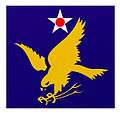25th Tactical Reconnaissance Wing
| 25th Tactical Reconnaissance Wing | |
|---|---|
|
25th Tactical Reconnaissance Wing Douglas RB-66B-DL Destroyer Serial 54-0419, converted to EB-66E on the runway at Chambley-Bussieres Air Base, France. | |
| Active | 1940–45, 1965–1966 |
| Country | United States |
| Branch | United States Air Force |
| Motto(s) | Guard With Power |
| Insignia | |
| 25th Tactical Reconnaissance Wing emblem |
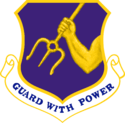 |
The 25th Tactical Reconnaissance Wing (TRW) is an inactive United States Air Force wing. Its last duty assignment was at Chambley-Bussieres Air Base, France.
History
The wing's lineage and honors can be traced not just through its own history, but through the history of two World War II organizations, the 25th Bombardment Group (Medium) and the 25th Bombardment Group, Reconnaissance.
World War II
25th Bombardment Group (Medium)
The air echelon consisted of:
25th Bombardment Group, Reconnaissance
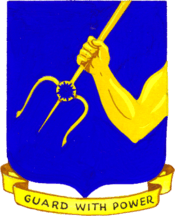
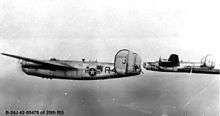
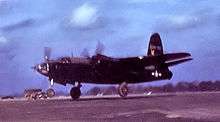
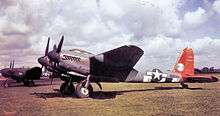
The 25th Bombardment Group (Reconnaissance) was formed at RAF Cheddington, England as the 8 Reconnaissance Group (Special)(Provisional) on 22 March, then changed to 802d Reconnaissance Group (Special)(Provisional) on 30 March 1944, and transferred to Watton on 12 April 1944. On 9 August 1944, the 802 RG(P) was redesignated as the 25th BG(R). Assigned squadrons were:
- 652d Bombardment Squadron (Heavy) B-17F/G, B-24J
- 653d Bombardment Squadron (Light) (WX) De Havilland Mosquito XVI
- 654th Bombardment Squadron (Special) B-25C, (XN) B-26G, A-26, (BA) De Havilland Mosquito XVI
Cold War
The 25th Tactical Reconnaissance Wing was activated on 1 July 1965 at Chambley-Bussieres Air Base, France as part of USAFE. Upon activation, the wing absorbed the 19th Tactical Reconnaissance Squadron and 42d Electronic Countermeasures Squadron. The squadrons were transferred from Toul-Rosieres AB, where they operated as a detachment of the 10th Tactical Reconnaissance Wing, based at RAF Alconbury, UK.
The 25th flew variants of the B-66 "Destroyers" on photo reconnaissance and electronic warfare missions. The 42d flew RB-66Cs that had a seven-man crew. Its primary mission was electronic reconnaissance, commonly called "Ferret" operations; the ECM operators were known as "Ravens" The 19th flew RB-66Bs with a three-man crew and the mission of day and night photography. Both squadrons flew its aircraft with a natural aluminum finish, the differences being that the 19th carried a red band on the engine nacelle; the 42d carrying a blue band. The 19th operated 20 aircraft; the 42d operated 12.
Having been reassigned from other wings, both the 19th and 42d were familiar with their missions and aircraft. But the wing was kept busy training newly assigned support personnel to operate and maintain the base. One major drawback of the B-66 was pilot training. It was always a problem because the B-66 was a single pilot aircraft and dual checkout was impossible. A large B-66 analog electronic flight-crew simulator built by Curtis Wright was very useful for checkout of the flight deck crew: pilot, navigator/camera operator, and gunner. Training the RB-66C ECM operators was more difficult since the USAF had not purchased a comparable electronic warfare simulator for their ground training. Thorough training in the RB-66B camera system was critical to accomplish the mission. The system was complex, involving three cameras, camera compartment temperature and pressure controls, flash bomb and camera shutter intervalometers, a universal camera control unit, a stabilized camera mount, and flash bomb bay operation. Later electronic warfare jamming transmitters were added to the RB-66s, increasing the mission workload.
Day and night photographic training was hindered by the 1965 ruling made by the French government that prohibited aerial photography over their country. This forced photo missions to West Germany and Great Britain. Night photography was limited since suitable ranges for dropping the M-120, and M-122 photo flash bombs were not available after the close of the USAFE Moroccan air bases.
The escalation of the conflict in Southeast Asia prompted the establishment of Detachment 1 of the 42d Electronic Countermeasures Squadron at Takhli RTAFB during February 1966. 6 of its B-66's were deployed on Temporary Duty to Thailand from Chambley to this new theater of operations.
On 7 March 1966, French President Charles De Gaulle announced that France would withdraw from NATO's integrated military structure. The United States was informed that it must remove its military forces from France by 1 April 1967. As a result of this, on 22 August 1966 the 42d Electronic Countermeasures Squadron was inactivated at Chambley and the majority of the aircrews, including sixteen EWOs and ten RB-66Cs were sent to the 432d Tactical Reconnaissance Wing based at Takhli RTAFB, Thailand. A few of the EB-66 aircraft were flown to Douglas Aircraft's Tulsa, Oklahoma plant for additional ECM equipment and camouflage painting before going to Southeast Asia.
About 1 August 1966 the 19th Tactical Reconnaissance Squadron (Photo) was ordered to move its twenty RB-66Bs to Shaw Air Force Base, South Carolina, and was assigned to the 363d Tactical Reconnaissance Wing. It flew its RB-66Bs from Chambley to Moron AB, Spain, then after refueling, it flew nonstop to Shaw with the aid of three air-to-air refuelings. Officially the 19th TRS was to become another of USAFE's dual-based units (units based in the U.S. but available for operations in Europe). Actually the squadron and its RB-66Bs were needed to train aircrews for the expanding combat operations over the skies of Southeast Asia during the Vietnam War.
On 15 October 1966 USAFE inactivated the 25th Tactical Reconnaissance Wing at Chambley as part of the USAF pullout from France.
Lineage
25th Bombardment Group (Medium)
- Constituted as 25th Bombardment Group (Heavy) on 22 December 1939[1]
- Activated 1 February 1940[1]
- Redesignated: 25th Bombardment Group (Medium) on 7 May 1942[1]
- Disbanded on 20 June 1944[1]
- Reconstituted on 19 April 1965 and consolidated with 25th Bombardment Group, Reconnaissance as 25th Tactical Reconnaissance Group
25th Tactical Reconnaissance Group
- Constituted as 25th Bombardment Group, Reconnaissance on 17 July 1944.[2]
- Activated on 9 August 1944[2]
- Inactivated on 8 September 1945[2]
- Consolidated with 25th Bombardment Group (Medium) on 19 April 1965 as 25th Tactical Reconnaissance Group and activated
- Organized on 1 July 1965.
- Discontinued and inactivated on 1 October 1965
- Consolidated with the 25th Tactical Reconnaissance Wing on 31 January 1984[3]
25th Tactical Reconnaissance Wing
- Established and activated as 25th Tactical Reconnaissance Wing on 24 September 1965[4]
- Organized on 1 October 1965[4]
- Inactivated on 15 October 1966[4]
- Consolidated with the 25th Tactical Reconnaissance Group on 31 January 1984[3]
Assignments
- GHQ Air Force, 1 February-26 October 1940
- 13th Composite Wing, 1 November 1940
- Panama Canal Air Force, January 1941
- VI Bomber Command, 25 October 1941[5]
- Second Air Force, 6 April 1944 – 20 June 1944
- 325 Reconnaissance Wing, 6 October 1944-c. 23 July 1945
- Seventeenth Air Force, 1 July 1965 - 1 October 1965
- United States Air Forces in Europe, 24 September 1965[6]
- Seventeenth Air Force, 1 October 1965 – 15 October 1966
Operational Squadrons
- 10th Bombardment (later Tactical Reconnaissance) Squadron, 1 February 1940 – 17 December 1943;[7] 1 October 1965 – 1 September 1966
- 12th Bombardment Squadron, 1 February 1940 – 20 June 1944[8]
- 35th Bombardment Squadron, 1 February 1940 – 20 June 1944[9]
- 42d Tactical Reconnaissance Squadron, 1 October 1965 – 22 August 1966
- 59th Bombardment Squadron
- Attached: 26 April-1 August 1943
- Assigned: 11 October 1943 – 20 June 1944[10]
- Attached: 1 November 1940 – 25 February 1944
- Assigned: 25 February – 20 June 1944[11]
- 9th Antisubmarine Squadron, (Attached from 26th Antisubmarine Wing) November 1942 – March 1943
- Stationed at: Miami AAF, Florida; Deployed to: Carlsen Field, Trinidad
- 839th Bombardment Squadron, (Attached from 26th Antisubmarine Wing) July–August 1942
- Stationed at: Miami AAF, Florida; Deployed to: Carlsen Field, Trinidad
- 7th Antisubmarine Squadron, (Attached from 26th Antisubmarine Wing) 20 April – 20 July 1943
- Stationed at: Miami AAF, Florida; Deployed to: Carlsen Field, Trinidad
Stations
- Langley Field, Virginia, 1 February – 26 October 1940
- Borinquen Field, Puerto Rico, 1 November 1940
- Edinburgh Field, Trinidad, 1 November 1942
- Hato Field, Curaçao, 1 August 1943
- Borinquen Field, Puerto Rico, 5 October 1943 – 24 March 1944
- Alamogordo AAFld, New Mexico, 6 April – 20 June 1944.
- RAF Watton, England, 9 August 1944 – 23 July 1945
- Drew Field, Florida, August – 8 September 1945
- Chambley Air Base, France 1 July 1965 – 15 October 1966
Major Aircraft Assigned
- A-17A (1940)
- B-18A/B Bolo (1940–1944)
- B-17F/G Flying Fortress (1944–1945)
- B-24J Liberator (1944–1945)
- B-25G Mitchell (1944–1945)
- B-26 Marauder (1944–1945)
- de Havilland Mosquito XVI (1944–1945)
- A-26 Invader (1944–1945)
- RB-66B/EB-66E Destroyer (1965–1966)
Notes and references
- 1 2 3 4 Maurer, Maurer, ed. (1983) [1961]. Air Force Combat Units of World War II (PDF) (reprint ed.). Washington, DC: Office of Air Force History. pp. 75–76. ISBN 978-0-912799-02-5.
- 1 2 3 Mueller, Combat Units, pp. 76-77
- 1 2 Department of the Air Force/MPM Letter 539q, 31 January 1984, Subject: Consolidation of Units
- 1 2 3 Ravenstein, Charles A. (1984). Air Force Combat Wings, Lineage & Honors Histories 1947-1977 (PDF). Washington, DC: Office of Air Force History. pp. 46–47. ISBN 0-912799-12-9.
- ↑ Conaway, William. "VI Bombardment Command History". Planes and Pilots Of World War Two.
- ↑ Until 1 October, the wing was a paper organization. On 1 October the mission, personnel, and equipment of the group were transferred to the wing and the group was inactivated
- ↑ Conaway, William. "10th Bombardment Squadron (Heavy)". VI Bomber Command In Defense Of The Panama Canal 1941 - 45.
- ↑ Conaway, William. "12th Bombardment Squadron (Medium)". VI Bomber Command In Defense Of The Panama Canal 1941 - 45.
- ↑ Conaway, William. "35th Bombardment Squadron (Medium)". VI Bomber Command In Defense Of The Panama Canal 1941 - 45.
- ↑ Conaway, William. "59th Bombardment Squadron (Heavy)". VI Bomber Command In Defense Of The Panama Canal 1941 - 45.
- ↑ Conaway, William. "417th Bombardment Squadron (Medium)". VI Bomber Command In Defense Of The Panama Canal 1941 - 45.
![]() This article incorporates public domain material from the Air Force Historical Research Agency website http://www.afhra.af.mil/.
This article incorporates public domain material from the Air Force Historical Research Agency website http://www.afhra.af.mil/.
- Endicott, Judy G. (1999) Active Air Force wings as of 1 October 1995; USAF active flying, space, and missile squadrons as of 1 October 1995. Maxwell AFB, Alabama: Office of Air Force History. CD-ROM.
- Freeman, Roger A. (1978) Airfields of the Eighth: Then and Now. After the Battle ISBN 0-900913-09-6
- Freeman, Roger A. (1991) The Mighty Eighth The Colour Record. Cassell & Co. ISBN 0-304-35708-1
- Hagedorn, Dan (1995) Alae Supra a Canalem: Wings Over The Canal, The 6th Air Force and the Antilles Air Command. Paducah, KY: Turner Publ. Co. ISBN 1-56311-153-5
- Malayney, Norman (2011) 25th Bomb Group (Rcn) in WWII. Atglen, PA; Schiffer Ltd. ISBN 978-0-7643-3950-9
- McAuliffe, Jerome J. (2005). US Air Force in France 1950–1967. San Diego, California: Milspec Press, Chapter 7, Chambley-Bussieres Air Base. ISBN 0-9770371-1-8.
- USAAS-USAAC-USAAF-USAF Aircraft Serial Numbers −1908 to present
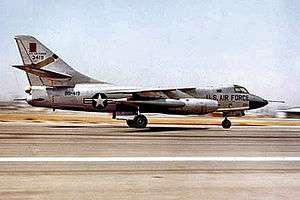
.jpg)
